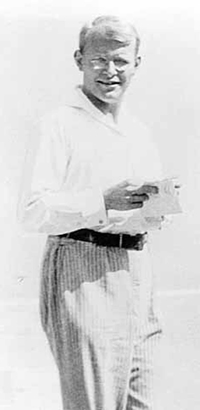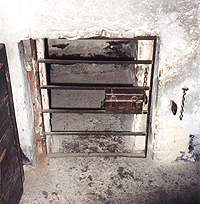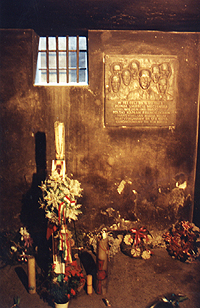



























|
September/October, 1998 Volume XIII Number 2


Monuments to the prophets
by Cathy Ramey
London, England--Ten new lifesized stone sculptures have been added to Westminster Abbey in England in an area reserved for 20th century martyrs for the faith. Among those honored as Christian martyrs are Martin Luther King, Jr., Catholic Archbishop Oscar Romero, and the beloved Maximillian Kolbe who offered to take the place of another man randomly sentenced to die by starvation at the Auschwitz prison camp during World War II. Kolbe asked that the other man, who had both a wife and children, be allowed to live, and so he was killed as a substitute by a lethal injection on August 14, 1941. A shrine of sorts marks the prison camp cell where Kolbe had been housed as an inmate.
The Grand Duchess Elizabeth of Russia, member of the household of the country's ruling family prior to the Bolshevik Revolution in 1918, and Manche Masemola of South Africa who was murdered by her parents after she converted to Christianity are also memorialized in the 900 year old British royal chapel.
Others include Lucian Tapiedi of Papua New Guinea, Esther John, Wang Zhiming, a Chinese pastor and evangelist, and Janai Luwun who vigourously opposed the regime of Idi Amin and who was charged by him with treason. His home was raided by soldiers in a search for treasures, and Luwun and two others were taken prisoner. He was shot in Kampala in 1977 before having a chance to defend himself and the Gospel in a formal trial.
 A punishment cell at KL Auschwitz. Prisoners had to curl into a fetal position in order to fit into the small enclosure. Maximillian Kolbe offered to take the place of a man selected to die there.
A punishment cell at KL Auschwitz. Prisoners had to curl into a fetal position in order to fit into the small enclosure. Maximillian Kolbe offered to take the place of a man selected to die there.
Dietrich Bonhoeffer fills out the roster of newly anointed martyrs whose monuments now stand a stern and silent guard in Westminster Abbey. Bonhoeffer is, perhaps, the most curious and controversial of the Church's fallen heros. Already teaching theological studies in Berlin before his 27th birthday, Bonhoeffer struck out on a path that led him into direct opposition to both the government of Nazi Germany and the Deutsche Christen ("German Christians") whose infiltration of the Church resulted in compromise with many of Hitler's evils.
Bonhoeffer's activism against both Nazism and the "German Church" involved acting as a double agent for the Military Intelligence. This position allowed him to leave and re-enter the country; it allowed him contacts with Germany's enemies; and it provided contacts with high German officials who sought to end the war and the atrocities wrought by the Nazi government by assasinating Adolph Hitler.
Efforts to save the Jews from total annihalation in European concentration and work camps meant smuggling information out regarding the transport of Jews into the camps. It meant creating false papers and coordinating traveling plans for refuges. A number of Christians, including several from the Bonhoeffer family, participated in these efforts.
Several, including Dietrich Bonhoeffer, were later arrested and accused of plotting to overthrow the government. Specifically, a bomb had been placed in a suitcase and positioned to go off at the feet of the Fuhrer during a military meeting in a bunker. Instead the briefcase was kicked aside and the blast minimized by a table. Hitler survived and began an all-out search for those within his government and military who might have been involved.
 Inside Maximillian Kolbe’s cell at KL Auschwitz
Inside Maximillian Kolbe’s cell at KL Auschwitz
As a result of his alleged involvement, Deitrich Bonhoeffer was imprisoned without a trial for over two years. Then, just as the war was coming to an end, papers were found in a safe which identified key members of the circle plotting Hitler's downfall, and Bonhoeffer's name was on the list. In early April of 1945 Adolph Hitler gave instructions to execute his own enemies within the camps and prisons. On April 9, Deitrich Bonhoeffer, having been moved to the camp for this occasion, was hanged after a hurried midnight trial at the Flossenberg prison camp compound.
While Bonhoeffer was deeply respected by many Church leaders throughout the Western world, he was not seen as a great hero until several years later, after the Church had gained some insight into his theological writings, as well as some distance from the conspiracy plot to which he was linked.
Today, his statue standing firmly in the Westminster Abbey, perhaps it is time to ask ourselves which of God's prophets are among us in the Church today, men and women who are scorned and imprisoned, but who have an even more firm and lasting position in the halls of heaven. It is a great pity to throw stones at fellow Christians like these, only to make much of them after they have died, men and women serving in areas of ministry to which we ourselves may not be called or areas which we have refused to go to simply because we find no comfort in the consequences of such service.
OTHER
IN
THE
NATION
ARTICLES
"Baby Phoenix" survives against all odds
Biskind incompetent
Missionaries invade Canada
Protest results in assault by police
Billboard campaign angers homosexuals, politically correct
Rome conference ends without consensus
Monuments to the prophets

© 1998 Advocates for Life Ministries
|
|

 A punishment cell at KL Auschwitz. Prisoners had to curl into a fetal position in order to fit into the small enclosure. Maximillian Kolbe offered to take the place of a man selected to die there.
A punishment cell at KL Auschwitz. Prisoners had to curl into a fetal position in order to fit into the small enclosure. Maximillian Kolbe offered to take the place of a man selected to die there. Inside Maximillian Kolbe’s cell at KL Auschwitz
Inside Maximillian Kolbe’s cell at KL Auschwitz